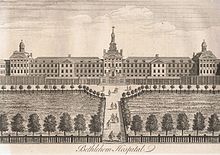William Henry Toms
Appearance
William Henry Toms | |
|---|---|
| Born | c. 1700 |
| Died | 12 September 1765 Westminster |
| Occupation | Engraver |
| Children | Peter Toms |


William Henry Toms (c. 1700–1765) was an English engraver. He worked on portraits, book-plates, landscapes and prints of buildings. Among his works were the plates for Robert West's "Perspective Views of All the Ancient Churches in London" (1736–1739).[1] In 1741, he worked with Thomas Badeslade on "Chorographia Britanniae or a New Set of Maps of all the Counties in England and Wales". The maps were republished on 29 September 1742, with additional place names.
Among Toms's apprentices was the engraver and publisher John Boydell.[2] W. H. Toms lived in Masham Street, London, and was the father of the painter Peter Toms.[3] Toms died in 1765.[4]
References
Citations
- ^ Redgrave 1878, pp. 433, 465.
- ^ Getty Research Institute.
- ^ Godfrey & Wagner 1963.
- ^ Potten 2004.
Sources
- Godfrey, Walter H.; Wagner, Anthony (1963), "Portcullis Pursuivant", Survey of London Monograph 16, College of Arms, Queen Victoria Street, London: British History Online, pp. 203–209, retrieved 11 June 2016
- Lee, Sidney, ed. (1899). . Dictionary of National Biography. Vol. 57. London: Smith, Elder & Co.
- Potten, Ed (May 2014). "Toms, William Henry (d. 1765)". Oxford Dictionary of National Biography. doi:10.1093/ref:odnb/50872.
- Redgrave, Samuel; Redgrave, Frances Margaret (1878). "Toms, William Henry, engraver". A Dictionary of Artists of the English School. George Bell & Sons. p. 433.
- "Toms, William Henry". Getty Research Institute.
